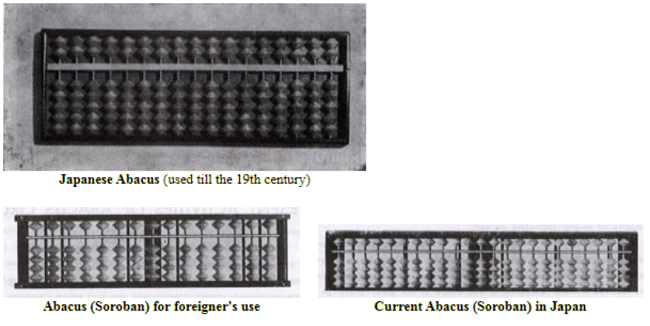Computer Components
Computer Memory
Computer Network
Computer Virus
Number Systems
Shortcut Keys
Terms
- What is a Browser
- Google Chrome
- Mozilla Firefox
- Internet Explorer
- Windows
- Computer Ports
- program
- Printers
- Microphone
- Monitor
- Motherboard
- Incognito Mode
- Mouse
- Memory Card
- CD
- ID
- ISO
- character
- server
- Keyboard
- Remote
- webcam
- Data
- URL
- keypad
- hub
- File
- Bytes
- Exabyte
- Gb
- Kilobyte
- Megabyte
- Petabyte
- Terabyte
- What is HDD
- What is SSD
- Memory vs Storage
- Non-volatile memory
- What is M.2 SSD
- How To Reboot A Computer
- Multi-Level Cell
- NAND Flash Memory
- What is the lock screen
- Block Storage
- Universal Serial Bus
- VRAM
- Cloud Hosting
- CompactFlash card
- What is WAP
- Classification of Memory
- Hardware vs Software
- Uses of Computer
- Uses of Internet
- Abacus
- Best Proxy Servers
- SSL VS. TLS
- Web Console
- GPU
- Difference Between LAN and WAN
- SSD and HDD
- Computer
- Data Migration
- JEDEC
- MLC vs. TLC vs. SLC NAND Flash
- VirtualBox Installation
- Num Lock
- PC
- MAC
- Continuous Data Protection
- Persistent Storage
- What is Bit
- Software Definition
- What is a File System
- When was the first computer invented
- How many generations of the computer
- Minicomputer
- Fourth Generation of Computer
- What is a Username
- What is ALU
Questions
Abacus
An abacus is a mechanical device that is used to calculate the arithmetic calculations quickly, also referred to as a counting frame. Its name was originated from the Latin word 'abax' or 'bacon.' Originally, it was invented thousands of years ago to perform arithmetic calculations, and today's is widely used in brain development programs. It comprises a rectangular frame that holds vertically organized rods on which beads move up and down. The main purpose of an abacus is to increase the brainpower of the children.
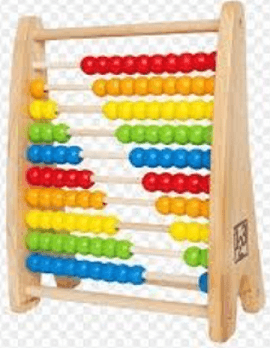
An abacus does not perform calculations by itself; rather, it helps users to calculate by remembering what has been counted. Some important points of an abacus are given below:
It is simply a device that includes a method of calculating from ancient times.
With the help of visualizing abacus bead movements, children can solve calculations in their minds speedily.
It has been proved by many pieces of researches that the abacus learners can use both sides left and right hemisphere of their mind.
It is not only helpful for arithmetic calculations but also powerful in all subjects.
Furthermore, it is also beneficial to improve the concentration level of children.
Why used an abacus?
In ancient times, when there were no computers, calculators, or a pen and paper for performing calculations, the abacus was only reliable to perform arithmetic calculations. Besides the abacus, people were used their toes and fingers or stones in the dirt for calculations. These methods were not suitable for long calculations, so an abacus was used at that point in time.
Who invented the first abacus?
Still, no one knows who had invented the first abacus tool. It is believed that Mesopotamia used an abacus for going back during 2700 B.C. Additionally, it was also used in other civilizations such as Greek, Egyptian, Chinese, Persian, Roman, etc.
Is the abacus still in use?
Yes, the abacus is still in use in some parts of the world for counting and to support modern counting devices.
Benefits of an Abacus
It provides several benefits; such are as follows:
- It provides help in various areas like Architecture, Engineering, Science, etc.
- It offers confidence in calculation-based subject as it makes the mathematical calculations easier.
- It is not only beneficial to improve the mathematical conditions, but it also helps to increase the overall academic skill level.
- It enables users to solve daily challenges easily and enhances problem-solving capacity.
- Many famous physicians have been researched that the left hemisphere of the brain, which is known as a digital brain that provides analytical knowledge and controls calculation, reading, writing, logical thinking, and more. And the right hemisphere, which is known as an analog brain that controls creativity, artistic senses, and three-dimensional sense. Science is believed in that if users regularly use the abacus; it can enhance the right side of the brain that helps to develop the whole brain of human beings.
- It allows children to enhance the skills of creativity, concentration, innovation, accuracy, imagination, speed, listening, etc.
- It helps dyslexic children who have low expertise in spelling, reading, and writing. It increases the level of their numerical skills as dyslexic children can understand by touching.
Function of Abacus
A human brain works with the help of sense organs; the motor nerves and sensory nerves in our body take the information from the organs to the brain and vice-versa. A brain takes input from the organs; thus, in an abacus, the beads are arranged in that way. When the children manage it by their fingers, the nerve endings get activated and then it activates the cells which are in the brain. When the left hand is used, the cells on the right side of the brain are activated. When the right hand is used on the abacus, the left side cells of the brain are activated. The left-brain activity is interpreting, and the right brain activity is visualizing. Therefore, both the left and right sides of the brain work commonly and help to whole-brain development.
How to use Abacus?
Before knowing how to use an abacus, understand there are several types of abacus available. For instance, two beads at the top and five beads on the bottom are contained by Chinese or classical abacus. The one bead at the top and four beads at the bottom are contained by the modern abacus tool, soroban abacus, or Japanese. We are taking the modern abacus as an example:
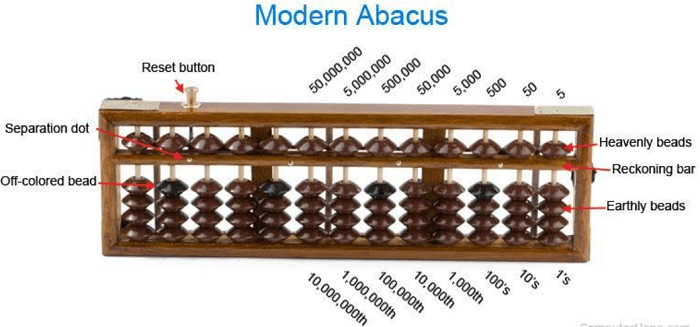
The beads that are located at the lower of the frame are called "Earthly beads," and these contain one value in the first column. The middle bar in the frame is called the reckoning bar. The beads are counted when they move towards the reckoning bar, and if any bead does not touch the reckoning bar, that column contains value zero. The off-colored beads and separation dots may be different on the different abacus tool but always have the same function of separating numbers into sets of three. If you do not want to start counting from the far right, these markers (separation dots and off-colored beads) have the ability to mark your first position. The bead's values start from the right-side 1's column and are valued between 1 to 9. The bead's values increase going from right to left in order to the 10's place, 100's place, 1,000's place, and more.
For using the abacus, put it on a plane surface and arrange it to zero, and make sure any bead is not touching to the middle bar (reckoning bar). You can also use the reset button to reset the beads if you have a reset button. With the help of your thumb, move one earthly bead to the reckoning bar. When one bead touches the reckoning bar, it makes the abacus equal to 1. Then, move three more beads to make the abacus value equal to four (3 + 1= 4), as the modern abacus contains only four Earthly beads. You need to move the heavenly bead down to the middle bar (reckoning bar) if you want to count to 5. You have to move with the help of your index finger. Simultaneously, you have to move all Earthly beads down and move two earthly beads up to the middle bar (5 + 2= 7) if you wanted the total to be 7.
If you want to count higher numbers, you need to move left on the basis of how high numbers you want to count. For example, as shown in the below picture, the abacus is equal to 283 included 9 beads moved to the reckoning bar. As shown in the upper image, the 3rd column (100's column) contains two beads that have counted for 200, and the second column, defined by 10's, contains a heavenly bead that is counted for 50, and three Earthly beads counted for 30. Finally, add all (1's, 10's, 100's) columns together (200 + 80 + 3) that gives you total 283.
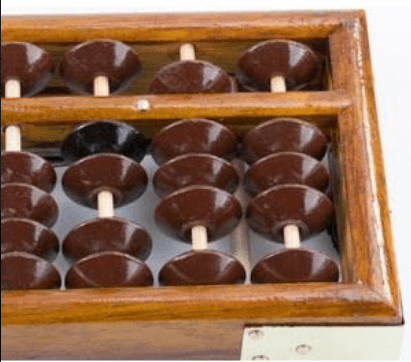
How to add numbers by using an abacus?
If you want to perform addition with the help of an abacus, you need to arrange each number to the abacus from left to right. For example, if you want to add 200 + 125, follow these given below steps:
Steps for solution:
- You have to move 2 Earthly beads in the 100's column to the reckoning bar (middle bar) for 200.
- Now, add 1 Earthly bead in the 100's column for 100.
- Then, add 2 Earthly beads in the 10's column for 20.
- Next, you are required to add 3 beads in the 1's column for five.
- Finally, you will be able to count 325 on the abacus once completed.
How can be subtracted numbers by using an abacus?
The subtracting process on the abacus is more similar to the adding process on the abacus. Set your first number in the abacus and minus from that number going left to right.
For example, first, you have to add 200 to the abacus with the help of moving 2 Earthly beads in the 100's column if you want to subtract 200 - 100. Then, minus 100 from the 100's column for getting answer 100.
History of Abacus
The word abacus was derived from the Latin word 'abakon' or 'abax.' It is a powerful device for arithmetic calculations, which was introduced between 300 and 500 BC. At the time of inventing, it traveled through various countries. The suanpan, one of the innovative Chinese abacuses, which had 2/5 decks, but it had more difficulty; so, it was replaced by a Japanese Soroban abacus, which was improved by a popular mathematician Seki Kowa.
Seki Kowa removed one bead all from upper and lower decks for making the abacus to 1/4 decks. The Soroban abacus is using in the present. It became popular after globalization when there was intense competition in the world on a common platform. It also influenced the education system of different countries. Furthermore, the abacus improves the overall conception of math, and it also enhances the problem-solving ability and faster calculation skills.
Types of Abacus
The types of abacus are described below with their history:
- Dust Abacus: In the form of a board covered with fine sand or dust, the abacus is commonly used for calculations. The sand was classified into lines, in which all lines describe a different numerical position. The numbers and quantities were calculated with the help of several marks, which had drawn with lines. It is believed that the civilization of Mesopotamia may have used this type of initial calculator.
- Line Abacus: Over time, it was developed into a ruled board, which had pebbles located on lines. It is widely used in Greece, Egypt, Rome, India, and other very old civilizations. Preserved at the Athens Museum, Salamis abacus is a popular example of the line abacus. It contains a white marble board on which lines are drawn.
- Grooved Abacus: Besides the line abacus, Romans was used as a highly advanced layout. Each of the upper groves contained one counter, and the lower groves contained four counters. Furthermore, some of the other counters were included on the right to make the calculation easier related to fractions.
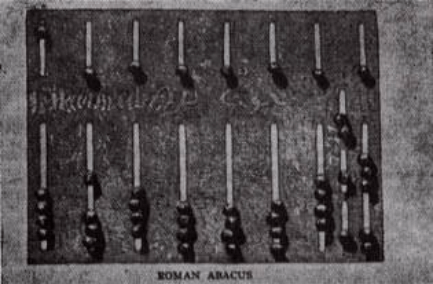
- Ancient Chinese Abacus: It was very similar to the old grooved abacus in both terms the construction and method of calculation. The below image describes the early Chinese abacus that was assumed from a book. This book's name was Mathematical Treatises, which was written by Hsu Yo around 1700 years ago, and later 300 years annotated by Chen Luan.
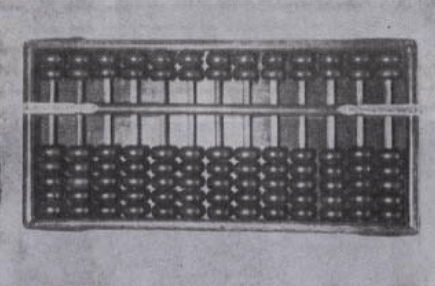
- Soroban (Japanese Abacus): In Japan, the Chinese abacus and its functionalities were introduced at the beginning of the 15th century. After a long time in Japan, a Japanese method of the soroban operation was introduced, which was different from the Chinese abacus method. It was developed after doing continuously and hard study by the popular mathematicians. The size of Chinese abacus was very large, it was improved and made a handier smaller-size.
Later, the soroban was introduced at the end of the 19th century on which each rod included one five-unit counter and four one-unit counters. It was introduced in use along with the older type abacus. The functionality of the soroban operation was mentioned in arithmetic compiled books of national grade-school by the Education Ministry in 1938.
Today, on each rod, one five-unit counter and four one-unit counters are contained by the standard soroban. The Japanese division method offers an easier way to make use of the multiplication table. It replaced the older Chinese division method that was able to make use of the complex division table. Two reasons are behind the popularity of soroban in Japan, which are given below:
- It was included in the syllabus of Japanese compulsory education.
- The enforcement of the soroban efficiency tests system since its establishment in 1928.
